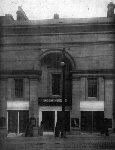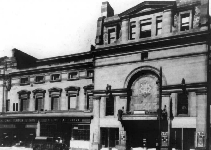The Search for Style: Cinemas of the 1920s [Part 2]
 |
One such project was the Caley cinema, opposite the Caledonian
Railway’s Princes Street Station and Caledonian Hotel, at the
foot of Edinburgh’s Lothian Road (1923). This had a
Renaissance-style fašade of Craigleith stone and was entered
through a Venetian arch.
The local architects James S. Richardson and
John R. McKay had designed it for a syndicate headed by the Edinburgh
businessmen Robert McLaughlin and Captain W.M Cameron. Within, it
initially seated 900 in a lofty auditorium the style of which reflected
the exterior. |
Such was its good reputation that after only four years,
it was closed for a major reconstruction supervised by McKissack.
Property was acquired behind shop units to the left of the Caley, and
so its direction was changed to run parallel to the rear of these.
| The
existing auditorium was incorporated to form the back section of the
new one, which could accommodate 1,800 and which was also heightened
with a mansard roof. Such radical rebuilding works were not uncommon
and time was of the essence for each day of closure lost the owners
money, so specialist cinema architects, such as McKissack, building
contractors and decorators became highly skilled at planning
construction work to cause a minimum of disruption. Cinema owners often
insisted upon penalty clauses to recoup losses suffered by delays, but
contractors were usually very careful to guard their reputations in
what was a lucrative and close-knit business. Evidently McLaughlin and
Cameron were well pleased with McKissack’s work on the Caley for
he went on to design a whole series of suburban cinemas for their firm
during the 1930s. |
 |
In Glasgow, meanwhile, McKissack was employed by George Smith and James
Welsh to design a new cinema at Cathcart on the city’s South
Side. Both Smith and Welsh were staunch Labourites - indeed George
Smith was the Corporation’s housing convenor and he believed that
cinemas were important social amenities, which greatly enhanced such
new housing developments. Smith was also an entrepreneurial businessman
and a cinema pioneer. He had first organised cinema shows in 1910 in
Corporation-owned halls around the city.
For this project, McKissack abandoned his earlier neo-classical
vocabulary in favour of a themed approach, no doubt influenced by the
suddenly popular American influence of ‘atmospheric’
design. John Eberson, an American interior designer, was the greatest
exponent of the style. Within, an ‘atmospheric’ cinema
would attempt to create the illusion that the seated audience was in a
wondrous courtyard, with internally-lit three-dimensional plaster
buildings and foliage adorning the walls and a smooth blue plaster sky
above, complete with projected cloud effects and twinkling stars. The
almost exclusively American films shown within their fake plaster walls
of such cinemas may frequently have been filmed in exotic locations,
but they were silent and in black and white. The
‘atmospheric’ cinema brought the fantasy world of the
movies alive in three-dimensional colour and the exciting architecture
became a part of the film-going experience.
The
Kingsway opened in 1929. It had a long, gently curving facade in a
fairly convincing Spanish American style, yet when it came to the
interior, McKissack appears to have run out either of inspiration or of
money for it was rather plain, albeit with Spanish-inspired details
such as the door architraves.
The advent of ‘talkies’ in 1928 gave the industry new
impetus and, thereafter, it expanded rapidly. Technically, films with
added sound were not a new idea as in 1907 a film of the variety star
Harry Lauder with a synchronised sound track on a record had been shown
at the Hippodrome Theatre in London’s Charing Cross Road. Warner
Brothers used their Vitaphone system to add sound to The Jazz Singer
with Al Jolson (1927), which was released in Britain the following
year, and The Singing Fool (1929). ‘Talkies’ gave the
cinema new potential and audiences grew bigger than ever. The advent of
talking films in 1929 led to a vast expansion of interest in cinema and
new buildings proliferated throughout the country.
Consequently, it was from 1927 until his death in 1940 that McKissack
designed most of his cinemas. The majority were in Glasgow and its
environs, although a few were built further afield, as far away as
Stranraer, Dundee, Kirkcaldy and Edinburgh. In the
1920s, his output was rather varied as he, like so many other cinema
architects, struggled to find a new and appropriate aesthetic for what
was a fast-moving medium in every sense.
Scotland had a particular affinity with cinemas in the 1930s and
Glasgow eventually had more per head of population than any other city
in the world. For a cinema proprietor, it was vital to attract
clients to their particular premises, and so the frontage of the cinema
was crucially important. This was not to be wondered at for the
cinema’s architectural expression originated in the fairgrounds
of the late-Victorian era and much of the carnival razzmatazz clung to
it as it developed from show booth to city to suburb. Consequently,
‘facadism’ prevailed with vivid colours, ornate columns and
canopies, advertisements and brightly tiled entrances attempting to
emphasise the elegance, luxury and modernity of a venue to passers
by. At night, when most people were likely to attend, facades
were enhanced by floodlighting and by strips of coloured neon. As
cinemas tended to occupy prominent high street locations, surrounded by
other buildings, their rear quarters were less visible. Thus, their
vast auditoria, while ornate inside, outwardly were usually little more
than an undecorated, windowless, brick clad sheds. There was
desperation to find a new and appropriate look to distinguish cinemas
properly from theatres and to signal their growing importance as venues
of the fastest-growing and most progressive entertainment of the period.
The prominence and decorative eclecticism of cinemas certainly made
them vulnerable to criticism and they incurred the wrath of
pro-modernist critics, such as Philip Morton Shand, Maxwell Fry and
others who were already looking to the recent German developments of
the Bauhausler and the expressionists, such as Eric Mendelsohn, and
demanding a purer architecture which would amply reflect and emphasise
the modernity of the cinema medium. Shand, in particular was so
incensed by what he considered the inability of British architects to
follow the trends set by continental modernists that in 1930 he
published a book,
The Architecture of Pleasure: Modern Theatres and
Cinemas to show how much better he felt contemporary German cinema
design in particular was than its British counterpart:
‘The newer ad-hoc buildings often vie with one another in that
nouveau-riche ostentation which their patrons are invited to envisage
as ‘the last word in luxury’... The design of our cinemas
is part of the heavy price we pay for our public neglect of
architecture…The desire of the film exhibitor being usually to
disguise his picture theatre as a showman’s booth, it is not
surprising that British architects have so far had no adequate chance
of trying to discover the cinema’s most logical and satisfactory
structural form…’
While his chosen illustrations with hindsight show that he was a man of
advanced taste, at the time it was perhaps too advanced for the
majority of the British audience. However, Shand’s book
demonstrates the influence of 1920s German cinemas on British buildings
of the 1930s; as it contributes to architectural desire to improve such
designs.
While Shand was clearly a man of advanced taste, it was perhaps too
advanced for a popular audience in an industrial city such as Glasgow.
While he advocated purity, a large cinema aiming to attract a
‘mainstream’ audience required to offer vivid colour and
decoration, so as to transport its patrons away from the possibly harsh
reality of life out with its walls. Thus, Art Deco and its derivative,
the Jazz Moderne style became popular for many cinemas (and, indeed,
cafes, bars and shops) in the early-1930s.